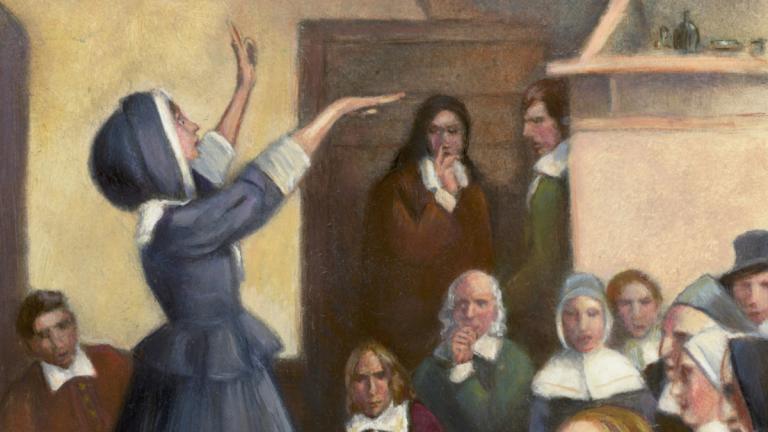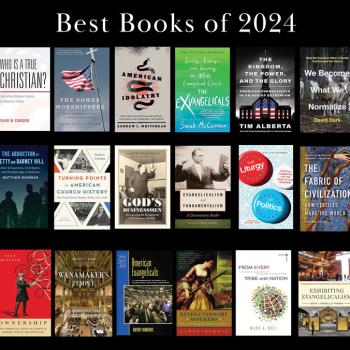I think Taylor Swift, J. J. Abrams, and pre-critical exegesis share something in common. They have mastered the method of employing “mystery” to foster enduring curiosity and interest in discovering the riches that their stories contain.

When I chat with my family about a new Taylor Swift album, the pull of Swift’s music that keeps my family members listening is that they want to unlock the secrets of the stories that she tells. They want to know what they “really” mean, and what is its “deeper” significance.
As I listened through the new double-album, The Tortured Poets Department: The Anthology on Friday, I anticipated a lively conversation with my 9th grade daughter and that evening after her varsity track invitational, we chatted about the poetic genius of “loml”, the power song and future tour favorite “I Can Do It With a Broken Heart”, the hilarious line “You should see your faces” in “But Daddy I Love Him”, and the cathartic and therapeutic power that will resonate with many in “The Smallest Man Who Ever Lived.”
My family members by all means are not alone on this. When I talk to others about Swift’s artistry, they commonly echo these interests. Sometimes they’ll disclose the little tidbits or “easter eggs” they’ve discovered. A Washington Post analysis of the recent album does just this. It provides a guide to some of the “easter eggs” in the album.
Taylor Swift has unlocked a method that J. J. Abrams also employs in his storytelling. Many years ago Abrams gave a compelling TED TALK on “The Mystery Box,” where he shared about the powerful role that mystery plays for awakening and inspiring imagination and fostering enduring interest in a story.
How Does Pre-Critical Exegesis Fit Into All This?
Now bear with me on this, I believe that the era of biblical interpretation referred to as pre-critical exegesis has consonance with J. J. Abrams and Taylor Swift’s genius of storytelling. It’s as if these storytellers have learned from the master storyteller himself. You see, one benefit that pre-critical exegesis offered as a method of unlocking the story of the Bible is that it stirred readers to search for deeper personal truth, spiritual truths, and even apocalyptic truths. Just like how listener’s linger over Taylor Swift’s lyrics to discover the “easter eggs” or the hidden backstory to her compositions, the pre-critical method of interpretation, that involved discovering the four-fold sense of Scripture, enchanted biblical interpreters for centuries, drawing them into deep study of the text to uncover its riches and explore its mysteries.
Back in the idyllic age of the early 80s, David Steinmetz wrote a masterful essay entitled, “The Superiority of Pre-Critical Exegesis.” In this essay, he analyzed various medieval practitioners of biblical interpretation and he made this audacious claim:
Only by confessing the multiple sense of scripture is it possible for the church to make use of the Hebrew Bible at all or to recapture the various levels of significance in the unfolding story of creation and redemption. The notion that scripture has only one meaning is a fantastic idea and is certainly not advocated by the biblical writers themselves. (Steinmetz, 8)
I would follow up with Steinmetz’s audacious claim by offering my own. I believe that there has been quite a bit of historical fallout as a result of the modern critical dethroning of the pre-critical method of interpretation. What has that fallout meant for the readers of Scripture? My audacious claim is that an element of intrigue, interest, and curiosity was wrest from readers of Scripture with the rise of modern exegetical methods.
It’s somewhat ironic that once vernacular texts became available for mass consumption, intellectual leaders reformed how Scripture was read. While some Reformed-Scholastics held onto old school practices of interpreting Scripture, theology and history with thick and deep readings of texts, many turned to a rigid and plain interpretation.
Some of the explanations for the new school of biblical exegesis can be explained by the need for men to control the narrative and reading of the text. They did this by preserving their authority over the text, restricting who could properly exercise authority over it. Since there was now a restricted range of theologically and spiritually appropriate meanings in the text, you had to be properly trained and credentialed. You had to earn a degree from a recognized learning institution like Oxford, Cambridge, Harvard, and Yale—places only men could study. And then once you had your degree in hand you had to be licensed by an ecclesial assembly that examined and approved that you accurately interpreted the text, kept theological fidelity, and could be trusted to exercise spiritual authority over a congregation.
In other words, there became quite a bit of control over the Bible, by men in authority over the Bible, as soon as men like Martin Luther introduced the idea of “private judgment” and others made the Bible available in vernacular translations and printed it in mass for people’s reading. Now that anyone with literacy could read the text for themselves, it became essential to control how it was read and who had authority over its proper reading.
Despite this attempt to control people’s reading of the Bible, many defiantly re-appropriated the imaginative pre-critical reading of Scripture. To these defiant readers, Scripture was already imbued with final authority and inspiration, but it offered multiple senses in which it might be understood. These multiple possibilities offered some flexibility in how its power might be wielded for the purpose of resistance and liberation from oppressive readings. People of color, women, the poor, and marginalized in society imaginatively claimed these alternative senses and readings to inspire their liberation.
This threatened current power structures and centers of power in the modernizing world. Thus, notions developed from empire and enlightenment, which served as powerful sources to tame people’s reading of Scripture. For a time, these notions maintained the traditional order of society, through a modern critical reading, that reduced scriptural interpretation down to one precise meaning, which only an expert could know.
The Anti-Hutchinsonian Sentiment of the 1630s
Nonetheless, significant figures would arise, who would challenge the standing authorities and their views. They would re-appropriate pre-critical methods of reading Scripture and they would harness pre-critical modes of understanding them.
One such person in the 1630s in New England was Anne Hutchinson. She challenged the standing order and accrued a large following, but eventually she was ousted and forced into refuge. When the authorities in Boston took her to trial, the matter of how she read the Bible and what authority she claimed to have over interpreting the Bible was a vital part of the trial.
One of her brilliant strategies in the trial was to take on the challenge of accepting their terms to how the Bible ought to be interpreted. She discoursed with them concerning the Bible and its exact interpretation. She detailed how she had interpreted it and what exact claims she made concerning it. During the course of the trial, she observed how imperfectly her examiners recalled events and how imprecisely they remembered her arguments and her statements about the Bible. This undermined her examiners’ authority over Scripture and potentially caused many of those common people witnessing the trial to lose confidence in those authorities. When it came to having a modern mastery over understanding Scripture, Anne Hutchinson demonstrated her superiority over the men of Boston.

But that didn’t matter to her because she fundamentally had a different understanding of how Scripture worked. She believed in a pre-critical method, where the Holy Spirit animated the senses and immediately revealed truths about the Scripture to the reader. She claimed this as being a valid experience of Scripture during her trial. Since the authorities understood this as being a radical view of the Holy Spirit and Scripture, the case was closed and they declared her guilt.
Immediately after Hutchinson’s exile from Boston, the Bostonian clergy established Harvard University in Cambridge (1638). They appointed Thomas Shepard to head the school. Shepard was one of the many ministers who had examined and exiled Hutchinson. Now, aspiring ministers would not have to travel back across the Atlantic to receive credentialed training, that could be much more liberal training. Rather, they could train men there, where they raised them, and they would be safely nurtured in a local nursery of Puritan scriptural interpretation and theological training.
Swift as Incarnation of Hutchinson and the Anti-Swift Sentiment
That said, it seems that Taylor Swift and Anne Hutchinson have quite a bit in common. In many ways, Taylor Swift is another incarnation of Anne Hutchinson. Both have experienced no small resistance to their efforts.
Just as there was an anti-Hutchinsonian sentiment in Boston, there has been a swelling anti-Swift sentiment as well. On the album release day, I asked my history students at Wheaton College how they had received the new Taylor Swift album, I was surprised by how much disdain I heard from some of the students. It reminded me that, around the time of the Super Bowl, there was an equal amount of disdain from these students and the middle school students at my church concerning the Kansas City Chiefs and Swift’s intervention in the world of football. Many of these young people were anti-Chiefs because they were anti-Swift.
Is it because of her poetic genius? Is it because she is a successful businesswoman and a powerful billionaire? Is it because she encourages people to vote? I think these are all part of the whole Taylor Swift package that both inspires her draw and detraction. But there’s something more there too.
While I’m still pondering the motivation for anti-Swift sentiment among these young people, I can’t help but see how they have been raised in a certain kind of nursery of social and cultural thinking that has trained them to have a disdain for powerful and influential women that break the mold of conservative values.
Perhaps this sentiment might be captured from this peculiar thread by the @thebereanmillen.
My two cents on Swift. Unsaved in college, I loved Taylor Swift. I knew every word to Red and all the other albums too. Her music is intoxicating bc she’s done a very good job capturing worldly relationships and hookup culture.
Now, as a believer– I stay far away from it. Why?…
— Katie (@thebereanmillen) April 20, 2024
Undoubtedly, Taylor Swift has become controversial among those who follow the conservative persuasion, and it is because she has been a disruption to their power. Leah Payne noted this in her recent publication, God Gave Rock and Roll to You (OUP, 2024), which Payne brought to people’s attention yesterday with her own thread (the inspiration of this special column).
Lots of @taylorswift13 talk today – among her many accomplishments, #TaylorSwift was also disruptive to the dominant #CCM biz model of the aughts, which aimed to present conservative white evangelicals with alternatives to mainstream pop stars.https://t.co/tsev45a2gU pic.twitter.com/OGgyYFb7Wf
— Leah Payne (@drleahpayne) April 19, 2024
Payne said in her history of the Contemporary Christian Music (CCM) movement:
The reign of virginal CCM pop starlets was eventually threatened, however, by a teenage singer from West Reading, Pennsylvania, named Taylor Swift. Swift was a pretty, petite blonde teenager who wore modest clothing and wrote chaste country songs with plenty of adolescent longing and Christian imagery. Swift’s third single, “Our Song,” depicted two teenagers who refrained from kissing and made sure to pray every night. “I think the real end for a lot of pop CCM was Swift,” observed former Forefront A&R representative Mark Nicholas; “the same moms who brought their daughters to CCM concerts felt comfortable bringing them to a Taylor Swift show.”21
Whether it was the fault of the Swifties or not, women of any age singing about anything at all were rarer and rarer on sales charts and Christian radio in the early 2000s. Women had always been underrepresented in CCM, but as rock-oriented worship music rose in prominence, their numbers dwindled further. (Payne, 145)

Taylor Swift ended up being a disruption to the reign of CCM musicians because she existed in mainstream culture and drew a large Christian following to her. Why did this happen? Is it simply because she “was safe for the whole family,” while being across the aisle in the land of mainstream. I don’t think it’s that simple. Rather, it is far more complex than that. I think she was offering something to these moms and daughters that they all longed for. They wanted a Madonna, who had the sensibilities of respectable Christianity. Lady Gaga wouldn’t work but Taylor Swift would.
Furthermore, I think it’s possible that anti-Swift sentiment is also driven by how she has awakened the imaginations and curiosities of young women globally. She is an inspiration to young blossoming artists and poets. She has enchanted them with a desire to unlock all the mysteries that her poetry offers. Quite frankly, as a human artist, she awakens the imaginations of her audience in the same way Scripture did to its readers during the era of pre-critical exegesis. She has drawn her audience in to read her story carefully, and she has succeeded in enchanting a generation of listeners.
When David Steinmetz concluded his famous essay on the “The Superiority of Pre-Critical Exegesis”, he appropriated an illuminating anecdote from C. S. Lewis:
I am inclined to agree with C. S. Lewis, who commented on his own book Till We Have Faces: “An author doesn’t necessarily understand the meaning of his own story better than anyone else.”8 The act of creation confers no special privileges on authors when it comes to the distinctly different, if lesser, task of interpretation. (Steinmetz, 12)
Taylor Swift has become a symbol of liberal power that has not bowed to other structures of authority. Her audience searches her poetic genius for catharsis, inspiration, and strength to persevere through pain or setbacks. Perhaps, that’s why she released her album on the anniversary of the “shot heard around the world,” the first engagements of the American Revolution at Lexington and Concord. As Swift keeps building momentum globally, this album is her poetic shout heard around the world.












